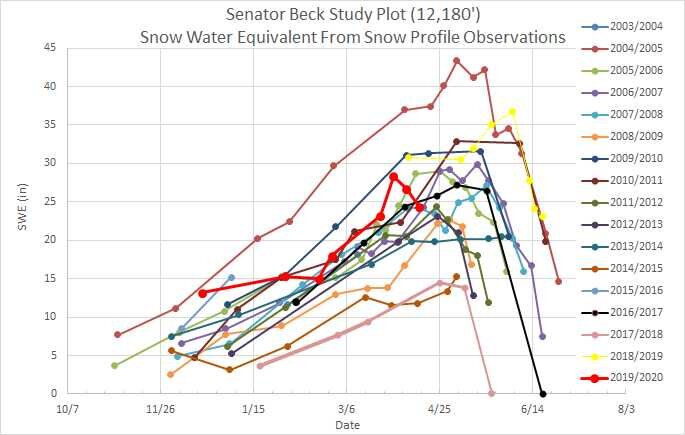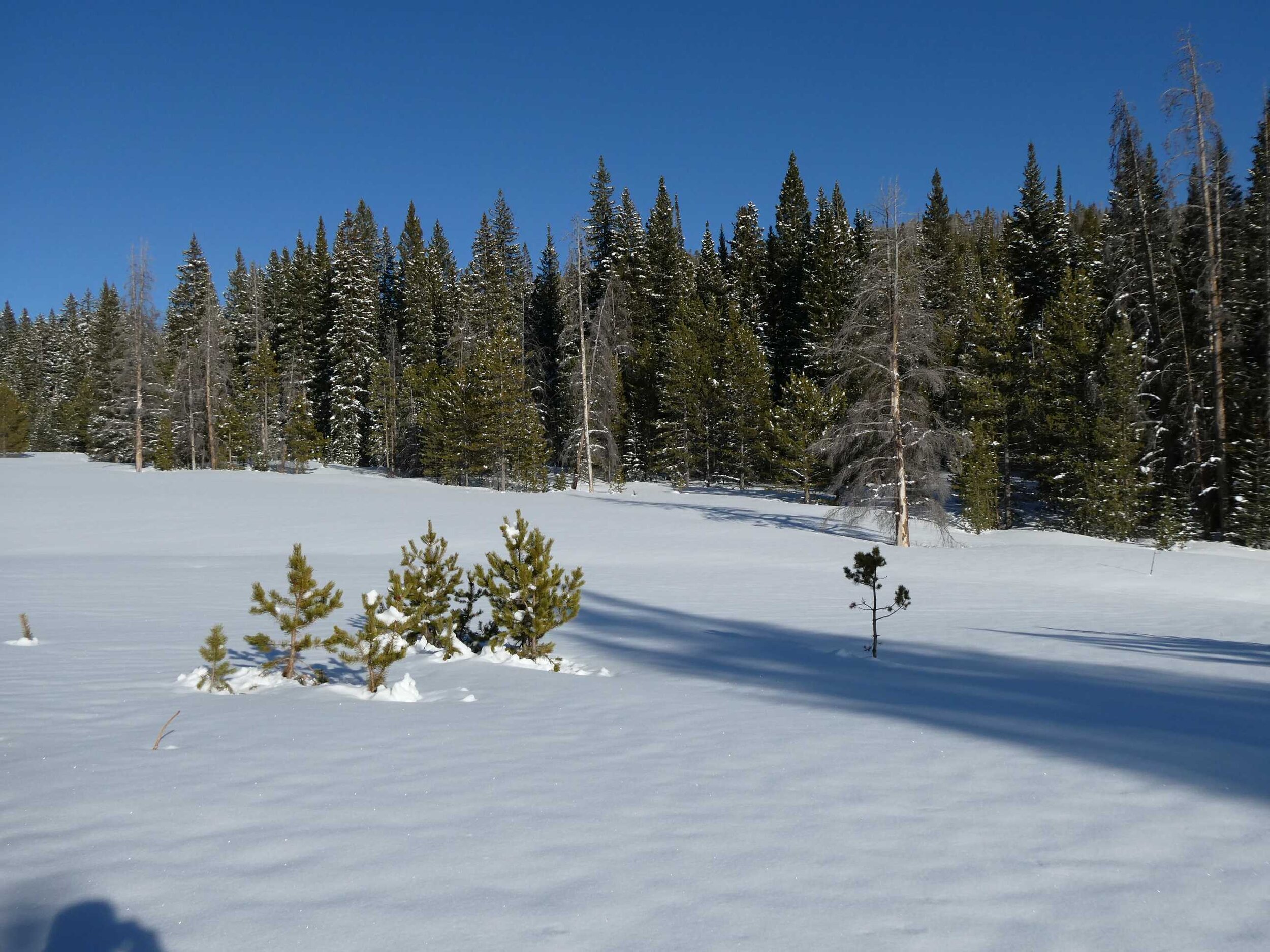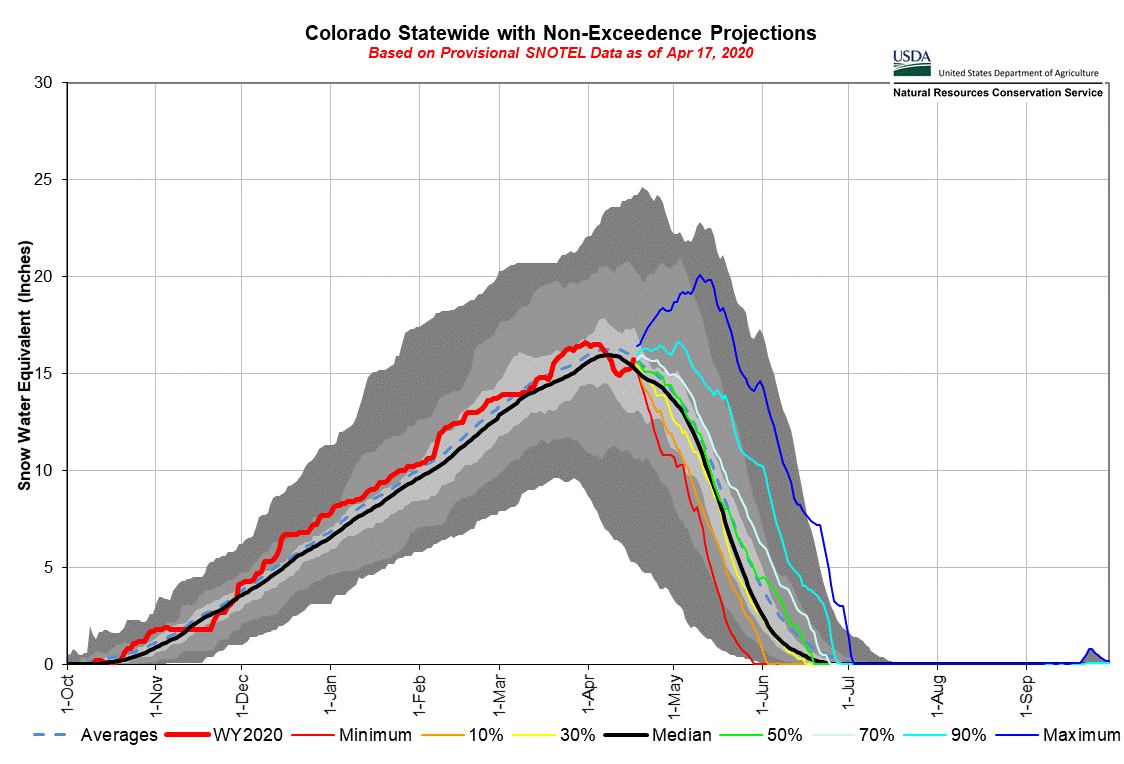April 19, 2020: CODOS Rabbit Ears and Willow Creek Observations, New Senator Beck research Publications
Greetings from Silverton,
Northern and Central Colorado benefited nicely from a productive storm Wednesday, April 15 – Thursday, April 16. Southern Colorado not so much as seen in the basin snow hydrographs. The South Platte Basin established a new peak, the Yampa and Upper Colorado Basin spiked back to their previous peaks, and the Rio Grande and San Miguel/Animas/San Juan showed a slight decline in SWE.
There are still some good chances of additional precipitation in Southern Colorado and state-wide in the forecast. The forecast is so multifaceted and uncertain I am not going to attempt a summary. But chances of precipitation (there appears to be no one big storm in the forecast) exist every day this week in the mountains. How much depends on location.
With cloudy and stormy weather looking to dominate this week (sunny conditions don’t look to take hold for any long stretch of time) combined with any dust (or older large rounded grains for that matter) currently being covered, would suggest minimal snowmelt for the coming week. We will keep the CODOS subscribers updated to how conditions are unfolding.
Hopefully you are all aware that Center for Snow collects a lot of snowpack and dust data, conducts research, and hosts researchers in Senator Beck Study Basin (SBB). Two research journal articles have just been published using CSAS’ field samples and automated station data. The first, Dust Deposited on Snow Cover in the San Juan Mountains, Colorado, 2011-2016: Compositional Variability Bearing on Snow-Melt Effects, was just released in Journal of Geophysical Research-Atmospheres. USGS researchers worked very hard characterizing light-absorbing particles from dust-on-snow deposited in Senator Beck. The results will inform snow radiation modeling and water resource management in the Colorado River Basin.
The second publication, Microorganisms Associated with Dust on Snow, was a research effort by the Cold Regions Research and Engineering Laboratory. The final document will be posted very soon at the link provided. By following the link you can request notification when it is available or if you can’t wait e-mail me and I can send you the final draft. This multiyear project quantified the amount, size, and location of dust particles within the snow using micro-CT imagery, then investigated the influence of dust on the specific surface area of the snow. Concurrently they determined microbial presence, composition, and influence from dust samples. There are a lot of questions as to the role microbes play in affecting the physical and chemical composition of the snowpack. We are pleased to host this research group and more publications will come out of this project, so stand by.
Rabbit Ears pass (April 17)
We visited Rabbit Ears on Friday, April 17 a day after a productive 2-day storm. We measured 16” new accumulation containing 2.8” water. A pretty wet storm. Rabbit Ears SNOTEL reported about 1” of new water. Total, Rabbit Ears is currently reporting 25.3” while our snow profile revealed 31” SWE. The mean temperature of the moist snowpack is -0.2 degrees C. The fresh snow surface is clean and highly reflective. We did not observe any dust in the snowpack. If there is any dust in the new snow accumulation it is highly diffuse and very light. Likewise, any dust that may be present in the old snowpack would have become noticeable through consolidation by now, so if present it would also be very light.
Willow Creek (April 17)
We also visited Willow Creek CODOS sample site on Friday. We observed 8.7” of new accumulation containing 1.6” of water. Willow Creek SNOTEL reported close to 1” new water from the storm. Total, Willow SNOTEL currently is reporting 15.3” SWE while we measured 9.8”. Similar to Rabbit Ears we did not observe any dust on the snow surface or within the snowpack.


















































